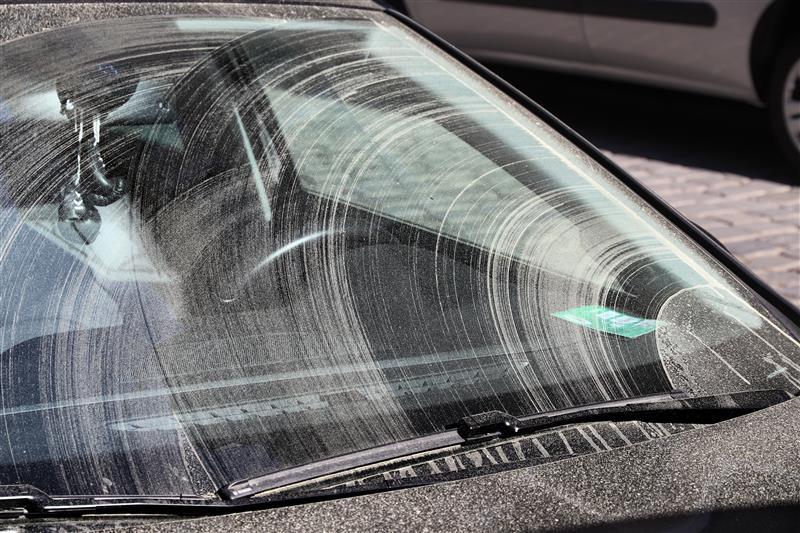
Spring brings warmer weather—and a fine layer of yellow-green pollen on just about everything. Glass surfaces like car windshields and home windows tend to show it the most. Pollen can dull the finish, aggravate allergies, and leave behind a stubborn film that doesn’t come off with a quick wipe.
Cleaning it takes more than a rinse. You need the right method, the right cloth, and a cleaner that won’t leave streaks behind. In this guide, we’ll walk through how to remove pollen from glass effectively, keep it from coming back too quickly, and leave every surface looking clear and polished.
Why Pollen Sticks to Glass and Won’t Wipe Off
At first glance, pollen seems like a lightweight powder that should wipe right off. But there's more to the story:
● Pollen is sticky: Pollen is coated in microscopic spikes that help it stick to surfaces. Add morning dew or humidity, and it bonds even tighter to glass.
● It combines with grime: Pollen rarely appears alone on windows and windshields. It blends with dust, sap, bird droppings, and air pollution, creating a sticky, dull film.
● Water alone won’t work: A quick rinse may wash off the loose stuff, but won’t break up the buildup. You’re often left with streaks, smears, or haze.
It takes more than a rinse to remove pollen. The right cleaner makes all the difference.
How to Clean Pollen Off Glass: A Step-by-Step Guide
Pollen sticks. Water streaks. But with the proper process, you can get glass surfaces looking spotless again.
Step 1 – Rinse Off Loose Pollen
Start by rinsing away loose pollen with low pressure. Use a garden hose for exterior windows or your car’s glass.
Avoid using high-pressure nozzles. Forceful water can push pollen deeper into seals or leave streaking behind.
💡 Pro Tip: Never dry-wipe pollen with a towel. It can scratch the glass, especially on windshields and sunroofs.
Step 2 – Spray a Streak-Free Glass Cleaner
Once rinsed, you’ll need a cleaner strong enough to remove the film that pollen leaves behind.
Recommended: Invisible Glass Premium Glass Cleaner. It breaks down pollen residue, grime, and oily film without leaving streaks or soap buildup.
Why Invisible Glass Works for Pollen
● Breaks down sticky, pollen-based buildup
● Dries quickly to leave a streak-free shine
● Contains no ammonia, dyes, or soaps
● Safe to use on tinted glass, windshields, mirrors, and household windows
Step 3 – Wipe with a Microfiber Glass Towel
Use a clean, lint-free microfiber towel made for glass. Avoid paper towels or cotton rags — they leave behind lint or smears.
How to clean:
- Spray Invisible Glass directly on the surface or onto your towel for indoor glass or sunny conditions.
- Wipe vertically, then horizontally to cover the whole area.
- Use a dry section of the towel to buff away any remaining moisture or haze.
💡 Pro Tip: Work in small sections. The cleaner evaporates fast, especially in warm weather.
Step 4 – Don’t Skip the Edges
Pollen loves to hide along the edges where the glass meets seals, trim, or weatherstripping.
Fold your microfiber towel and use the corner to reach tight areas. On cars, check around window seals, sunroof edges, and wipers for buildup that can turn to grime over time.
What About Inside Your Car?
Pollen doesn’t just settle on the outside; it can also work inside your vehicle. Cabin air filters don’t catch everything, especially when you open windows or doors.
Use Invisible Glass and a microfiber towel to clean:
● Interior windshield
● Side windows
● Touchscreens (spray on towel first)
● Rearview mirrors
Cleaning these areas helps reduce haze and improve visibility, especially at night, when pollen and dust can cause glare.
How to Prevent Pollen from Sticking to Glass
You can’t stop pollen from floating through the air, but you can make your glass less likely to trap it and easier to clean when it does.
1. Use a Glass Sealant or Water Repellent
After cleaning, apply a product like Invisible Glass Clean & Repel. This 2-in-1 formula cleans and leaves behind a slick, invisible barrier that helps prevent buildup.
Benefits of using a glass treatment:
● Repels pollen and dust so they’re less likely to cling
● Helps water bead up and roll off
● Reduces how often you need to clean
Use it on windshields, exterior windows, or shower doors to extend that just-cleaned look.
2. Keep Windows Closed on High Pollen Days
On days with elevated pollen counts, keep your windows, sunroofs, and patio doors closed. Closed windows minimize how much pollen settles on both interior and exterior surfaces.
3. Stick to a Weekly Cleaning Routine
During pollen season, wipe down glass surfaces weekly. Regular cleaning prevents buildup from combining with tree sap, pollution, or road grime, making your next cleanup much easier.
Final Thoughts: Clean Glass, Clear View
Pollen comes with the season, but it doesn’t have to cloud your windows or windshield. With the proper technique and a reliable glass cleaner, you can remove it quickly and leave every surface streak-free.
Whether heading out for a drive or letting the spring sun in through your windows, a simple routine helps keep your glass clear and your space allergy-friendly.



